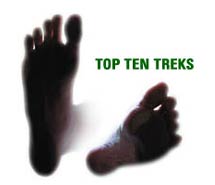|
Day One:
Distance: 2.5km
Our tour of Tasmania's Tarkine Coast begins with a drive from Launceston to Burnie and then South to Corinna, a historic mining town on the banks of the Pieman River. From here we board the Arcadia 2 (an historic Huon Pine ferry) and cruise down the rain forest flanked Pieman River for 1 ½ hours. On arrival at the coast, we disembark and walk north to our camp for the night. The camp is located on the edge of the Southern Ocean. After exploring the sheltered pools you can kick back with a fabulous meal and a glass of wine and watch a Tasmanian west coast sunset.
Day Two:
Distance: 8km
We walk north along the Tarkine coast, crossing numerous rocky headlands, creeks, rivers and twisted rock formations. The camp is sheltered behind the headland of the Interview River. Giant aboriginal shell middens surround the headland providing testimony to the long period of aboriginal inhabitation. On arriving at camp you can walk down to the Interview River and swim in its warm and sheltered waters.
Day Three:
Distance: 8 km
We cross the Interview River continue north along expansive beaches bordered by huge wind-swept dunes. The majestic Southern Ocean rolls in with giant breakers sending rooster tails of foam and spray into the air. In the distance lies the headland flanking the Lagoon River where we camp. The headland is surrounded by Aboriginal middens and provides expansive views down the deserted beaches. There is another opportunity for a refreshing dip in the fresh water of the Lagoon River.
Day Four:
Distance: 9kms
On route to Sandy Cape, we cross a number of headlands and rivers including the Italian River. The day's journey includes more encounters with huge midden sites and other examples of the Tarkine Coast's remarkable heritage. Sandy Cape is a large headland and was home of the Tarkinner Aboriginal people, from which the region derived its name. Sandy Cape is flanked by spectacular granite boulders creating a number of secluded and sheltered swimming pools. The sea life in these pools including Mollusc's, Abalone, and an abundance of sea weeds provides hours of exploration.
Day Five:
Distance: 2 km
We explore the spectacular sheltered bays and lighthouse of Sandy Cape. From here the vast scale of the Tarkines' button grass, coastal heath and tall Eucalypt rain forest extends out to the horizon. The Norfolk range stretches out to the east framing the spectacular bay of Sandy Cape beach. Before lunch, take an invigorating dive into the pristine waters of the Southern Ocean and see if you can spot an abalone. After lunch our 4wd vehicle collects us and we drive north to Arthur river and back to your accommodation.
|





